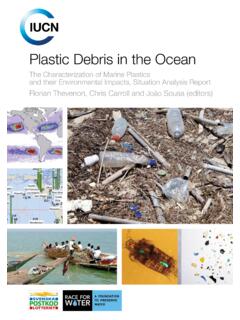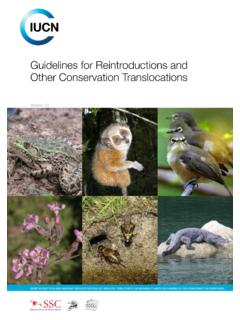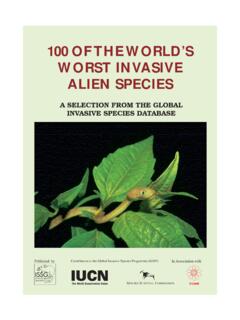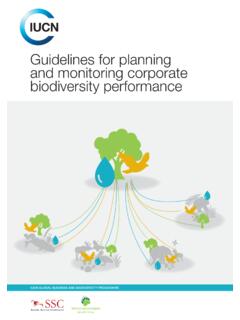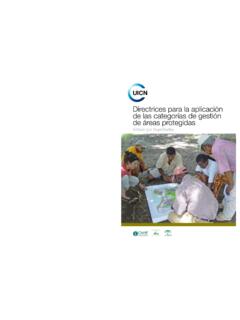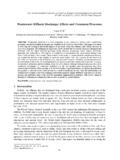Transcription of Siting and Design of Hotels and Resorts
1 Siting and Design of Hotels and ResortsPrinciples and Case Studies for Biodiversity Conservation The designation of geographical entities in this book, and the presentation of the material, do not imply the expression of any opinion whatsoever on the part of IUCN concerning the legal status of any country, territory, or area, or of its authorities, or concerning the delimitation of its frontiers or views expressed in this publication do not necessarily reflect those of publication has been made possible in part by the generous funding from the French Ministry for Sustainable Development and the French Overseas Territories by: IUCN, Gland, SwitzerlandCopyright: 2012 International Union for Conservation of Nature and Natural Resources Reproduction of this publication for educational or other non-commercial purposes is authorized without prior written permission from the copyright holder provided the source is fully acknowledged.
2 Reproduction of this publication for resale or other commercial purposes is prohibited without prior written permission of the copyright : Siting and Design of Hotels and Resorts : Principles and Case Studies for Biodiversity Conservation Gland, Switzerland: IUCN. 56 : 978-2-8317-1471-4 Design /Layout: Thad MermerProduced by: IUCN Business and Biodiversity ProgrammeAvailable from: IUCN (International Union for Conservation of Nature) Publications Services Rue Mauverney 28 1196 Gland Switzerland Tel +41 22 999 0000 Fax +41 22 999 0020 guide is printed on FSC paper made from wood fibre from well-managed forests certified in accordance with the rules of the Forest Stewardship Council (FSC).Cover photos (each row from left to right, top to bottom) Fairmont Mayakoba Boutique Immagine Sunset World Dana Allen & Wilderness Safaris Jimmy Livefjord Monolo Yllera G.
3 Lynas, NYC Fairmont Mayakoba Bay of FiresBack cover photos (each row from left to right, top to bottom) Oskar Henriksson Russel Friedman & Wilderness Safaris Bay of Fires Isla Palenque Mike Myers & Wilderness Safaris Eleanor CarterSiting and Design of Hotels and ResortsPrinciples and Case Studies for Biodiversity Conservation Project coordinators Giulia Carbone (IUCN, Global Business and Biodiversity Programme)T a Garc a-Huidobro and Deirdre Shurland (UICN, Mesoam rica e Iniciativa Caribe)Authors The Biodiversity Principles for Siting and Design of Hotels and resortsGillian Cooper and Yves Renard, Green Park Consultants The case studies illustrating the Biodiversity PrinciplesJackie and Richard Denman, The Tourism CompanyEnglish editor Amy SweetingDesign and layoutThad MermerFundingFrench Ministry for Sustainable Development French Overseas Territories MinistryIUCN would particularly like to thank all the individuals who have provided valuable inputs commenting, reviewing and advising on the various elements of this project.
4 AcknowledgmentsBiodiversity is the variability among living organisms from all sources including, inter alia, terrestrial, marine and other aquatic ecosystems and the ecological complexes of which they are part: this includes diversity within species, between species and of ecosystems. - Convention on Biological Diversity3 Fairmont Mayakoba4 Part III 16 Implementing the Biodiversity Principles for Siting and Design of Hotels and Resorts : Case StudiesAbout the case studies 16 Principle 1Q-Station, Australia 18 Tres Rios, Mexico 22 Chumbe Island, Tanzania 25 Principle 2 North Island, Seychelles 28 Isla Palenque, Panama 31 Fairmont Mayakoba, Mexico 33 Principle 3 Bay of Fires, Australia 35 Soneva Fushi, Maldives 38 Maho Bay and Concordia, US Virgin Islands 40 Principle 4 Misool Ecoresort, Indonesia 42 Campi ya Kanzi, Kenya 45 Principle 5El Nido and Taytay, Philippines 47 Northeast Brazil.
5 Brazil 50 Part II 10 Biodiversity Principles for Siting and Design of Hotels and ResortsPrinciple 1 11 Adopt an ecosystem-based approach in tourism development planningPrinciple 2 12 Manage impacts on biodiversity from hotel development and attempt to achieve an overall positive contributionPrinciple 3 13 Design with nature and adopt nature-based solutionsPrinciple 4 14 Respect, involve and support local communitiesPrinciple 5 15 Build collaboration among stakeholdersContentsPart I 6 Hotel and Resort Development and Biodiversity: Risks and OpportunitiesConclusions 54 Glossary 56 Part II: Biodiversity PrinciplesPart I: Risks and OpportunitiesPart III: Case StudiesConcclusions and Glossary5 El Nido Resorts6 Integrating biodiversity considerations into Siting and Design decisions for hotel and resort developments is important not only for the continued viability and conservation of the ecosystems, but also for the long-term financial success of the Hotels and Resorts .
6 The tourism industry, including the hospitality sector, depends strongly on healthy ecosystems, because those ecosystems and the wildlife, habitats, landscapes and natural attractions that comprise them are often the very thing that draws tourists to the destination in the first place. Biodiversity is essential for human life. It provides human society with many important benefits and services: for instance, insects pollinate our crops, birds disperse seeds, and fungi, worms and micro-organisms produce nutrients and fertile soils. Interactions between organisms and the physical environment influence our climate, water supplies and air quality, and help protect us from extreme weather, including mitigation of natural disasters.
7 These benefits are collectively known as ecosystem services (The Millennium Ecosystem Assessment, ). It is therefore not surprising that biodiversity plays an important role in the day-to-day life of a hotel: from the food in the restaurant and wood in furniture and fittings, to the amenities in the spa, the products of biodiversity are everywhere inside Hotels . Outside, plants and animals make a hotel s public areas and gardens attractive for guests, while beyond the hotel gate, national parks, green spaces, coasts and natural habitats provide guests with opportunities for recreation and biodiversity footprint of Hotels and Resorts Despite their dependence on and interconnectedness with biodiversity, Hotels and Resorts can have significant negative impacts on ecosystems and natural resources.
8 A hotel impacts biodiversity at each stage of its life cycle, from planning through to closure: At the planning stage, the most important issue in determining the level of impact that a hotel will have relates to choices about its Siting and Design . Choices about the materials that will be used to construct the hotel, where those materials will come Part I Hotel and Resort Development and Biodiversity: Risks and Opportunities Mike Myers & Wilderness SafarisPart I: Risks and Opportunities7from and the total physical footprint of the hotel will also influence how significant its impacts will be in the operational stage. At the construction stage, impact is determined by the size and location of the area cleared for development and where construction activities are taking place; the choice of construction methods; the sources and amount and type of materials, water and energy used to build the hotel; the location of temporary camps for construction workers; inadequate storage facilities for construction materials; the amount of construction waste that has to be disposed of; and other types of damage, such as surface soil erosion or compaction caused by construction activities or disruption of natural water flows and drainage patterns.
9 In the operational stage, a hotel s impact comes mainly from the energy, water, food and other resources that are consumed in running the hotel; by the solid and liquid wastes it produces; by the way its grounds are managed and by the direct impacts of its guests. In addition, regular renovation and replacement of furniture, appliances and facilities can cause impacts through purchasing choices and increased waste generation. Using energy and water more efficiently; using organic and sustainably produced food; reducing, treating and disposing of waste appropriately; making sustainable purchasing decisions and managing gardens with natural-style plantings can all help a hotel to reduce its adverse impacts on biodiversity. Similarly, a hotel s relationship with host communities not only affects the sustainable operations of the hotel but also the use of environmental resources by communities themselves.
10 At the closure stage, a hotel s impacts come from the disposal of materials removed from the hotel to refurbish it, convert it for other uses, or demolish it, and from the work involved in these activities. It may be possible to reuse and recycle some materials, but there may also be some toxic materials, particularly from older buildings, which will require careful handling and management. A responsible hotel operator should also foresee supporting activities of ecological restoration as required. Biodiversity issues should be a part of decision-making from the very beginning of any planning phase through to the end of closure. While this document focuses mainly on the first two stages, planning and construction, Siting and Design decisions also influence the impact a hotel will have during its operation: a hotel that is designed to use resources efficiently and blend in with its surroundings will be much more sustainable to operate, and the site will be easier to restore at impacts associated with the Siting , Design and construction of Hotels and resortsImpacts of land clearing and landscape modificationChanges in local land use and cover is, according to the Millennium Ecosystem Assessment, one of the main drivers affecting biodiversity and the ability of ecosystems to provide ecosystem goods and services.


